Recruiters are some of the hardest working professionals out there. They’re often tasked with sourcing, screening, interviewing, coordinating, compiling vital information, onboarding, and ultimately helping make a hiring decision.
Recruiters simply can’t afford to waste time or lose great talent in the process, which is why there needs to be a change. The many manual tasks that exist must be automated and streamlined so that recruiters can focus on strategic priorities that make sizable impacts on their companies.
Not only are manual recruitment tasks wasting valuable time, but they’re also losing your hard-earned talent. Manual tasks may be allowing strong, talented candidates to slip through the cracks by either creating a poor candidate experience or making your team slower to interview or offer than your competitors.
Manual recruitment tasks that you can automate
Manual tasks in recruitment are inherent to almost every part of the job—from sourcing and processing candidates, to reporting on the performance of your programs. There are a wealth of tools in the market today that can help reduce the manual workload across all areas of recruitment.
Here are nine of them.
1. Sourcing and uploading profile
Candidate sourcing needs to be fast—especially in a competitive market.
The sooner a candidate is screened and invited for an interview, the sooner they can potentially be taken off the market. Despite the need for speed, sourcing candidates outside of your own talent pool or database can be time-consuming and a painstakingly manual task in recruitment.
Downloading CVs and profiles across platforms (like Facebook, LinkedIn, or GitHub), only to have to save them and then manually upload them into your ATS or CRM, costs you valuable time. Even if you source and upload in batches, you may be risking leaving one candidate in your download folder. Additionally, you may want to consider that keeping candidate data on individual computers and outside of your ATS may be a GDPR compliance risk.
Using an ATS like Recruitee by Tellent lets you streamline your sourcing process. Our Google Chrome extension allows you to upload candidate profiles in just a few clicks, saving you from manual data entry, and ensuring that the captured data is alway reliable.
Watch the video below to see how it works.
To use the tool, simply:
- Browse to a user profile on a supported service
- Click the Recruitee icon on the top right corner of your browser
- Follow the prompts to import the profile information for one or more job positions in Recruitee
Once added to Recruitee, recruiters can tag candidates, parse data into candidate profiles, detect duplicate profiles, and move candidates to jobs or other talent pools.
2. Sifting through Excel sheets for candidate information
While Microsoft Excel has been a handy addition to a recruiter’s toolkit, data laws and an increase in the wide risk of viruses have caused data loss and breaches.
Excel sheets individually stored on computers can pose risks to your data security, erode team collaboration and perpetuate manual tasks in recruitment.
Creating even a basic spreadsheet requires extensive manual data entry and is undoubtedly time-consuming to keep updated. If you’re looking to speed things up, you can always add formulas, but these aren’t often common knowledge and can take a lot of money and time in training.
Remember, people make mistakes. It’s human nature. And human error can (and do regularly) remove crucial information or mistype emails or phone numbers. The continued use of Excel in your day-to-day will not only waste precious time but also can pose a serious risk to your data security and candidate data access.
Recruitee’s Pipelines feature offers an automation solution. Rather than continuously updating disparate spreadsheets and risking data security, this feature allows recruitment teams to customize stages, create templates, and automate tasks to reduce your manual work.
You can adapt each process and automate elements for specific roles, turning on candidate reminders and schedulers without worrying that anything is slipping through the cracks.
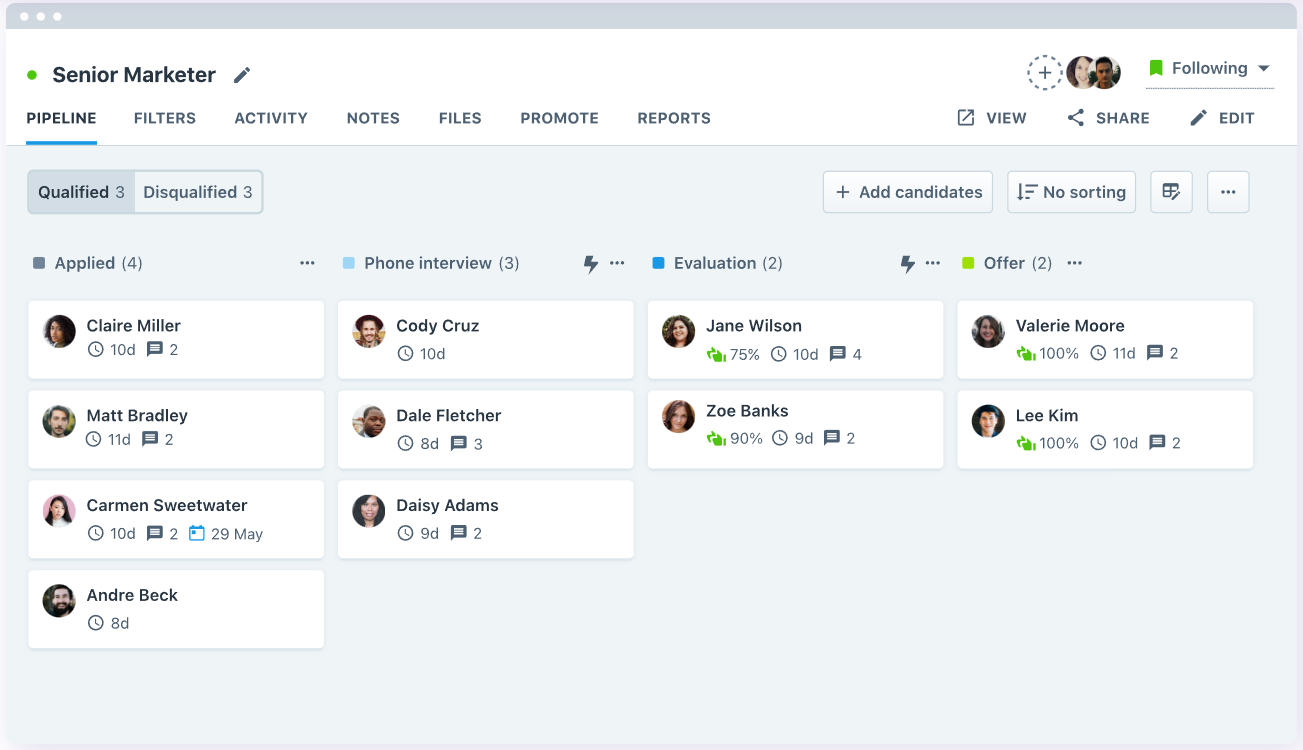
3. Managing candidate communication
There are lots of communication touch points during the hiring process that can add a significant amount of manual work to a recruiter’s plate. The average time to fill for a tech position in 2023, for example, is 52 days. This means that recruiters need to be on top of regular communications touchpoints over roughly a two month time period.
This can include:
- Application acknowledgment
- Initial outreach from the recruiter
- Interviewing scheduling and reminders
- Interview follow-ups
- Decision emails
- Offer emails
- Onboarding emails.
And, all of this has to be handled remotely and at scale across a pool of potential hundreds of candidates. Not doing so effectively can harm your employer brand and cause top candidates to drop off during the hiring process.
Recruitee offers email templates and scheduling capabilities to help you automate and plan mass communications to your talent pools.
The platform comes with a variety of out-of-the-box email templates for each checkpoint above, but you can also create your own. These can include templates for general communications, auto-confirmations when candidates apply, and event invitations with video call links.
Custom templates in Recruitee can also include dynamic and placeholder text to automate personalization across your entire candidate pool.

Recruitee also allows you to schedule and manage all communications through a single platform. You can schedule emails to be sent on a specific day or time, or relative to when the candidate’s profile is updated—for example, scheduling a rejection email if a candidate does not pass the screening phase.
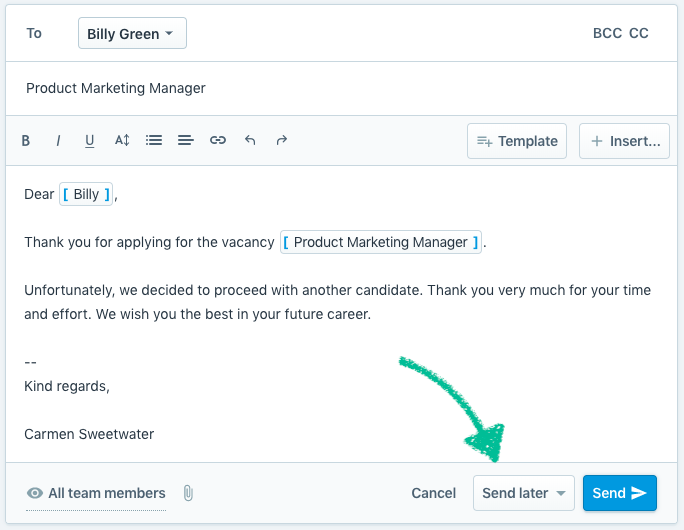
4. Posting on multiple job boards
Posting a vacancy across multiple channels and platforms is, without a doubt, the best way of gaining diverse applications. However, it’s also a manual task in recruitment that could be wasting your time when it comes to managing the postings individually.
If the details of an opportunity change or a requirement is unexpectedly closed, you would have to go into each platform and manually edit or remove the posting. Failing to do so could mean that you get applications for a position that has been closed, creating a poor candidate experience. Or if you haven’t edited the post, you may be misinforming candidates who apply.
Recruitee’s multi-posting and smart campaigns feature allows you to access more than 2,900 job boards—both free and paid—in your local area and abroad. By using an ATS system like Recruitee, you’ll receive instant notifications whenever an application is received, meaning manually checking across all 2,900+ job boards is a pain of the past.
You’re also able to update these boards with a tap of a button, ensuring you don’t need to go into job boards individually anymore.
Here’s how it works.
By default, Recruitee automatically sends any job with a Publish status to Indeed.com. You can also manually select if you want to publish your jobs to other available job boards, including:
- Google for Jobs
- Bookle
- Adzuna
- Talent.com.
The screenshot below shows how easy it is to select those boards.
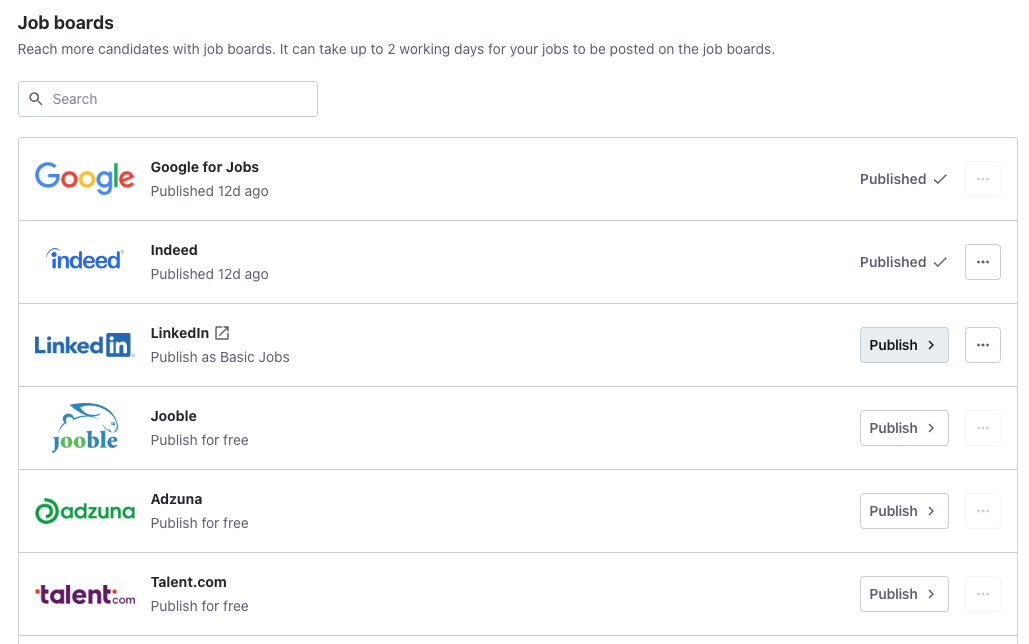
Once published, you can also share the postings with your network and social media accounts through Recruitee. Use the “Share” tool, as shown below, to capture links for each job post, and drop it into your desired platform.
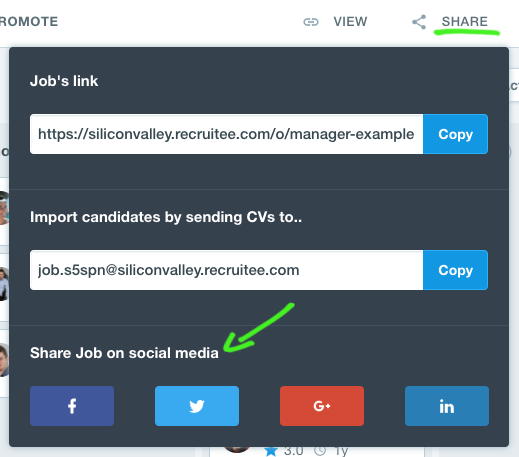
5. Scheduling interviews
Scheduling interviews with your hiring manager and candidates can be the ultimate game of cat-and-mouse. Once you have your candidate on board for one date, the hiring manager is no longer available to interview them. Or vice versa.
Many emails can be exchanged before you’re able to lock down a time and date for the interview. By then, your candidate could be interviewing elsewhere.
Scheduling interviews is one of the more painful manual tasks in recruitment. Additionally, with its manual nature, placing the meeting in everyone’s calendars leaves room for human error.
Can you sense a pattern? Manual tasks consistently mean that recruiters risk losing out on great talent.
Recruitee’s Event scheduler is specifically designed to automate your interview processes. Here’s how.
With the scheduler, you can:
- Streamline your schedule and have your candidates choose a time slot that suits them based on your team members’ connected calendars.
- Share scheduler links with candidates via email or text, sending them to a landing page where they can pick the best time.
- Easily navigate hybrid and remote work arrangements with our “Meeting Rooms” features, along with invitations to virtual meetings.
- Connect your teams’ calendars to scheduler to make it clear when everyone is available to chat.
All of the above features greatly reduce the number of back-and-forth emails that are needed to schedule each individual employee, giving recruiters significant time savings.
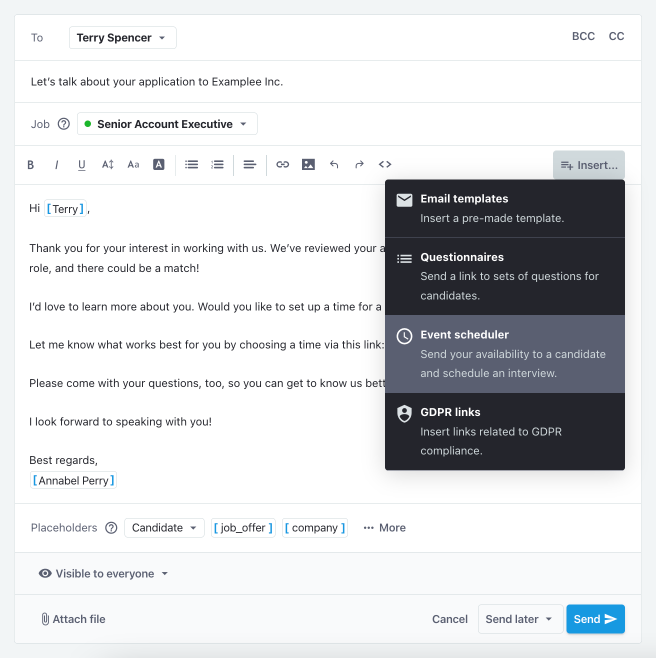
6. Creating talent pools
Recruiters should always be thinking about future positions to fill, especially in a candidate-driven market. The best way to do that is to build long-term professional relationships with both active and passive candidates. This is known as talent pipelining.
Building a talent pipeline is a long-term strategy that relies on sourcing and nurturing candidates. Doing this manually often involves creating a spreadsheet that you’re constantly editing, growing, and fiddling with. Again, there’s large scope for human error here. It is nearly impossible to stay on top of multiple talent pipelines when they’ll likely need changing daily alongside all the other tasks recruiters need to complete.
There's no better way to keep on top of a growing talent pipeline than with Recruitee, where you can easily access your talent pipeline database and keep the lines of communication open with prospective candidates.
Once you receive an application, you can add it to your database and track applicants for your current job openings. The database retains all applicants' information, which is essential for meeting long-term staffing needs. You can also share information about your talent pipeline easily with your team.
Automating your talent pipeline can help you stay on top of your company's hiring needs and locate quality candidates faster. Forward-thinking companies use it as a way to nurture candidates and stay on top of their hiring process.
7. Screening candidates
Reviewing resumes to shortlist candidates based on their qualifications and experience. This involves manually going through each resume to assess if the candidate meets the job requirements.
When sifting through hundreds of CVs, it can be difficult to keep on top of all the applicants and whether they truly meet your job requirements.
This is where automating screening questions can help. You can automatically narrow down your list to easily select applicants who match your criteria, from skillset, location, education requirements, whether they’re authorized to work where your company is based, etc. The list goes on!
Pre-screening can go beyond just asking candidates questions. With an ATS, you can also send out questionnaires and tests to assess whether applicants are a fit for the role. These tests can be used to determine a number of things, including work aptitude, personality traits, and scenario-based situations. If a candidate spends the time to fill out these tests, then that is also an indicator that they’re willing to make an effort to pursue a career at your company.
Recruitee automates candidate screening in two key ways.
First, the assess and evaluate candidates tool in Recruitee allows everyone on your hiring team to share feedback about candidates after they screen and interview them. Candidates receive scores based on evaluation from the team, which can be used to make a decision about their progression.
Evaluations can include short or detailed written feedback and a simple thumbs-up or thumbs-down score. These evaluations are added to the candidate profile. The rating they receive will count toward the candidate’s average job fit score. Learn how evaluation scores are calculated.

Second, recruiters can also use this tool to fill out detailed grading criteria for candidates after an interview takes place. Hiring team members can open the candidate’s profile, CV, and job details in a single window, allowing them to work through a step-by-step grading process based on pre-set criteria.
Once the evaluation form is completed, the user can leave a note and a final evaluation score, which is also added to the candidate profile for future decision-making.
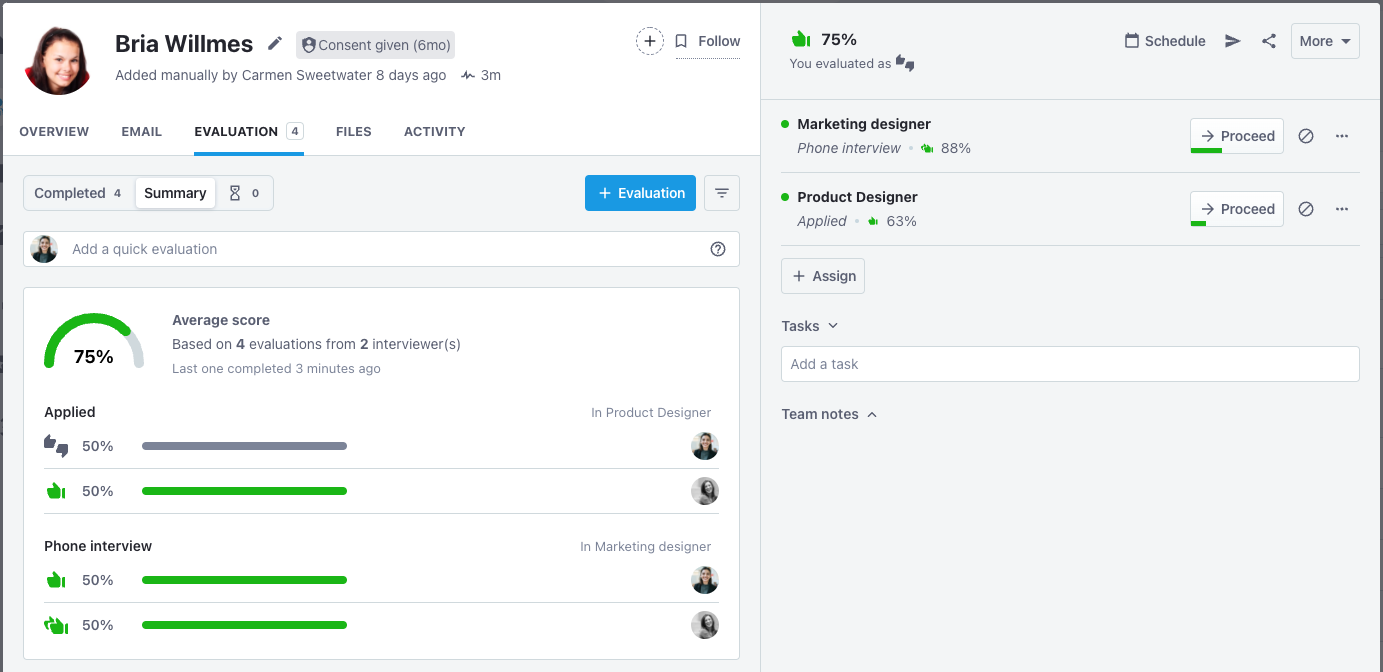
8. Approving requisitions
Requesting, reviewing, approving, and actioning job requisitions has always been a headache-inducing experience for recruiters.
Hiring managers or department leads must identify the need for a new position and send a request for a new placement to HR. Once that requisition comes in, it needs to be reviewed and approved based on the business rationale and potential impact. Then, the recruitment team needs to meet with the hiring manager to understand the role and the ideal candidate's persona.
Lots of information needs to be collected and processed during this process, including:
- Title and role level
- Position description and job requirements
- Temporary or permanent position
- Department
- Suggested work location
- Salary range
- Is the position in the budget?
- Is this a new or existing position?
- Suggested working hours
- Supervisor
- Equipment and software
- Target start date.
The problem is that this information is often scattered across spreadsheets, emails, and Slack chats. There may be no easy way to track planned or requested roles, budgets, and whether or not all of these requisitions are aligned with the company’s strategic roadmap.
Recruitee’s requisition approvals feature makes this process easier by centralizing and automating much of the information and processing noted above. Managers can quickly create new requisitions and share them directly with all relevant stakeholders. All relevant information is kept in one place, including the budget for the position, the number of openings, the reason for hiring, and more.
Approval and review steps can be set within Recruitee, ensuring a smooth handoff between all stakeholders. This dramatically speeds up the review process, ensuring that recruiters can get started sooner with their hiring efforts.

9. Reporting on recruitment metrics
Data and reporting are an integral part of every recruiter’s role. It’s how you identify trends that point to success or failure in your recruitment process and lead to new strategies or solutions. For many, however, this data is spread across numerous tools, spreadsheets, and layers of permission. This can make it difficult and time-consuming when it comes time to report on your strategies or assess your progress.
The key is to centralize this data and present it in a way that’s easy to digest for recruiters, HR managers, and hiring teams.
Recruitee offers a variety of templates and customizable boards that present vital recruitment data at a glance. You can customize reports from our library and filter them based on what matters to you.
This includes:
- Creating your own board with multiple reports pulled from different sources
- Selecting any number of analytics reports to add to your board
- Editing, re-arranging, and adding to your board over time
- Downloading a CSV report for deeper analysis
- Creating views for all jobs, or filtering for specific jobs and departments.
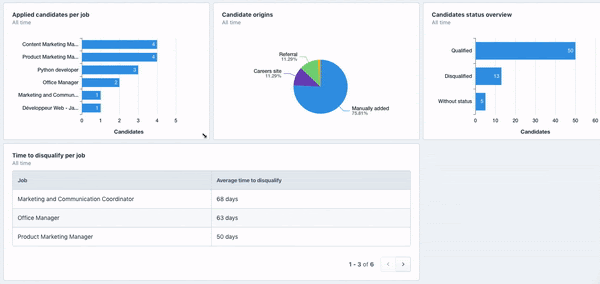
Conclusion
Many, if not all of the manual tasks mentioned above are critical to do, but they don't all need a complex solution.
Recruitee offers a wide range of features to reduce the frequency of manual tasks and make your life easier as a recruiter.
If you're curious to find out more, sign up for a free 14-day trial today to learn more about it.


-1.jpg?width=1600&name=6641f517e3e6161a68fec425_african-american-entrepreneur-and-coworkers-analys-2022-03-31-18-25-15-utc%20(3)-1.jpg)





